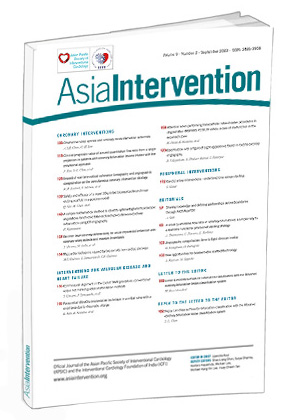We appreciate the interest shown by Dr Movahed1 regarding our review, “DEFINITION criteria for left main bifurcation stenting − from clinical need to a formula”, which was recently published in AsiaIntervention2.
The treatment of coronary bifurcation lesions is generally challenging, with Medina 1,1,1 and 0,0,1 subtypes associated with an increased risk of target lesion failure3. The Movahed bifurcation classification system tends to exclude the importance of Medina 0,1,1, but it indicates the importance of side branch lesions. Among the different classifications for coronary bifurcation lesions, the Medina stratification4 is the most extensively used, although it lacks some critical information correlated with clinical outcomes. Thereafter, serial classification systems were introduced, including the MADS (Main, Across, Distal, Side) classification system5 and the Mohaved classification system6. These stratifications guide the stenting selection based on the concept that a 2-stent technique is more frequently required for severely diseased side branches, and provisional side branch stenting may be associated with fewer clinical events for “simple” lesions. The remaining unresolved question is whether all “true” bifurcations are the same? This unmet need drove the birth of the DEFINITION criteria2. The subsequent DEFINITION II trial7 has further confirmed the utility of the DEFINITION criteria, represented by a higher rate of target lesion failure after provisional stenting for complex bifurcation lesions.
Coronary bifurcation lesions are relatively common among coronary artery lesions undergoing stenting. While the interventional community has achieved dramatic progress in understanding the mechanisms (particularly the abnormal distribution of shear stress), the importance of intravascular imaging guidance and how to select a stenting approach, we are still facing a mass of unclear topics. Further research is warranted to promote patients with complex coronary bifurcation lesions.
Conflict of interest statement
The author has no conflicts of interest to declare.

